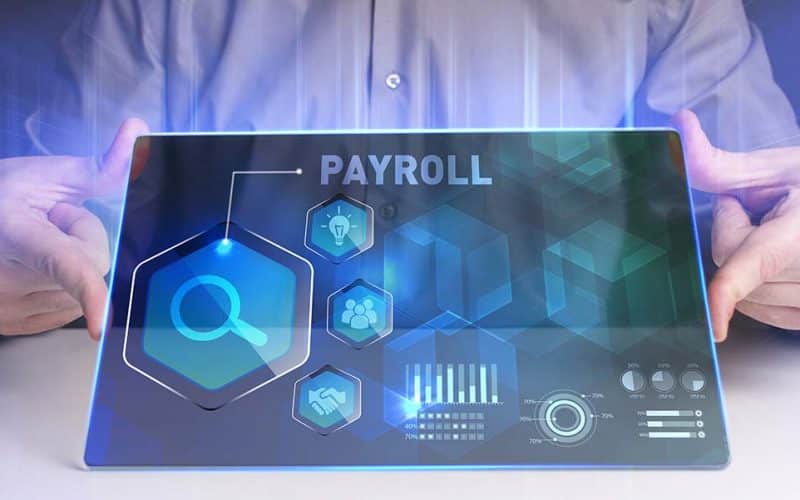Payroll software is a system that manages payroll services such as payroll taxes, salary, year-end bonuses, pay stubs, paid time off, benefits management, and employee record organization. Several businesses outsource their payroll software, but you may decide that doing it in-house is ideal for your business. However, there are many payroll software solutions available to help with the process.
However, deciding which solution is best for you might be difficult. We’ve prepared this guide to help you understand the vendor environment, and you can also choose from the 10 best payroll software.
Payroll Software Functionality
This type of solution maintains a range of information linked to employee salary and also frequently includes benefits management functions. This comprises everything linked to earnings (pay type and frequency, bonuses, withholdings, garnishments, and so on): paid vacation and time off benefits, as well as one-time or recurring benefits such as health insurance, educational assistance, moving expenses, and retirement plans.
When preparing a run, the system will calculate payroll deductions such as federal taxes, municipal taxes, and state taxes (including Social Security, Medicare, unemployment, and also disability insurance). They will then print payroll checks or make direct deposits, and export data directly to accounting software or in a format compatible with import into an accounting system. It should also cover compensation for mileage, relocation for new workers, and also other travel expenses, as well as any additional expenses borne by employees.
Finally, the software should generate tax forms and reports for the employer, employees, and contractors, such as the 940, 941, 944, 1099, W2, W3, and 1099-MISC.
Payroll Software’s Advantages
If your firm is manually maintaining employee information and making payments, payroll solutions could save you time, money, and also a lot of hassles by reducing compliance issues.
#1. Save time.
The most obvious benefit of a payroll management system is that it saves time, which saves money. These systems are meant to be user-friendly, so the learning curve to set up and begin processing payroll is relatively short. These time saves add up.
#2. Reduce risk by increasing accuracy.
A payroll software system can also assist business owners in ensuring they remit the correct amount of paycheck-related taxes and file necessary reports on time. When running payroll manually, even a little miscalculation, such as a multiplication or rounding error, might have serious consequences. These solutions will handle tax files and reports for you and remind you when they are due.
Simply keeping up with changes to the tax code is a time-consuming effort. Payroll software will keep track of these changes for you so you don’t have to.
#3. Produce reports.
Finally, payroll systems enable you to track payroll information over time. It’ll rapidly provide valuable reports for internal decision-makers, accountants, and auditors. So, a payroll report may include details of quarterly costs, annual tax remittances, and historical employee benefits participation.
What kind of buyer are you?
Payroll is often only one component of a company’s software requirements, although this is not always the case. There are numerous degrees of purchasers, and the following categories will assist you in determining the software that will best meet your needs:
#1. Small businesses:
A small business owner trying to streamline their payroll operations will desire payroll software with a low base price. Moreover, you’re probably doing your own payroll at the moment, so you’ll need to locate the best payroll software for your small business.
#2. Mid-Size Businesses:
Human resources specialists at midsize organizations or larger (50+ employees) will benefit from more than just basic payroll procedures. At this stage, onboarding, direct payment, tax filing, and other features like attendance tracking and time tracking become more valuable. So, the buyer will desire a more comprehensive human resources management system.
#3. Large businesses:
These purchasers want to go beyond the human resources department and also into an enterprise resource planning (ERP) package. This includes full-service payroll processing, talent management, and possibly the human capital management system. This will enable tight integration between payroll and other HR processes, as well as accounting and other department-specific systems.
Another factor to consider is the sort of operating system (OS) on which the software will be run. For example, if you use a Mac, you might want to check into goods designed exclusively for the Mac interface. Alternatively, an increasing number of goods are OS-agnostic, which means they are optimized to function in a web browser. Hence, they are not dependent on a specific operating system.
When selecting online payroll software, the availability of a mobile app may also be a consideration. You won’t be able to conduct payroll or file taxes, but employees will be able to request time off, update personal information such as phone numbers, and make adjustments to other payroll options.
Professional employer organizations (PEO) and administrative service organizations that want to track payroll services for their employees may consider PEO software.
Understanding Market Trends
More payroll software is now available on the internet. Software-as-a-Service (SaaS), a deployment paradigm in which the vendor hosts the software on its own servers and clients access the solution via a web browser, is becoming more common for payroll applications. Because tax regulations change regularly, any online payroll software you purchase will need to be updated at least once a year. Online payroll solutions are a fantastic solution to this worry because vendors automatically update the software with legal changes, making tax compliance simple for you.
Employee portals are growing more prevalent. Across the board, HR software is becoming more employee-centric. Employee portals are becoming more widely available, both as SaaS and on-premise systems. Look for additional employee-focused capabilities, such as employee self-service tax filing, access to personal payroll data, personal benefits, banking details for direct deposit, paystubs, timesheet data, and absence auditing and reporting.
Features Of Payroll Software
- Calculating the pay of employees
- Calculating withholdings deductions automatically
- Check processing via direct deposit
- Checks are printed for employees who are not enrolled in direct deposit.
- Creating tax documents
- Integrating with third-party payroll providers
- Issuing checks on a sporadic basis or on-demand payments
- Keeping track of each employee’s salary history
- Taking care of benefit plans
- Taking care of retirement planning
- Payroll auditing and tracking
- Salary adjustments and revisions for employees
- Payroll balance and calculation data are updated on a regular basis.
- Self-service for employees
10 Best Free Payroll Software Review
#1. BambooHR
Rather than having to spend hours each month manually transferring data and worrying about accuracy, BambooHR makes payroll administration simple, quick, and stress-free. BambooHR data updates immediately flow into payroll, practically eliminating data duplicate entering. Furthermore, with complete payroll reporting, better customer service, and full-service tax filing, you’ll save time and anxiety on payroll setting, freeing you up to focus on other vital objectives.
#2. Paychex Flex
Paychex Flex is an all-in-one payroll and human resources solution that you can expand or adapt as your organization expands. Use it to conduct payroll and also to integrate your HR administration, retirement, and insurance management with service tailored to your needs and our expert knowledge of the rules that may influence your organization. So, for a limited time, you can get three months of free payroll processing.
#3. Gusto
Gusto is a cutting-edge online people platform that assists small businesses in managing their staff. The tools and services assist you in onboarding, paying, insuring, and engaging your workforce in a single integrated, user-friendly platform used by over 100,000 modern businesses. Gusto makes taking care of your workforce a pleasurable experience, while also assisting you in managing your bottom line and remaining compliant. No matter how intricate the scenario, you’ll feel like a pro. So, collaborate with Gusto to build a workplace where everyone thrives.
#4. Paylocity
Paylocity’s comprehensive product suite provides a unified platform for professionals to make strategic decisions about benefits, core HR, payroll, talent, and workforce management, all while developing a modern workplace and enhancing employee engagement. The platform can be accessible 24 hours a day, seven days a week from any location by utilizing the mobile application.
#5. Paycor
With Paycor, you can help your corporation enhance productivity, decrease compliance worries, and also restore the time you need to focus on business strategy. Paycors’ all-in-one HR and payroll solution eliminate the need for manual labor. The user-friendly interface walks you through each step of the process. Thus it allows you to get in and out of payroll quickly. All personnel information is available in a single location. Import employee hours directly, view cash requirements before filing payroll and manage employee details.
#6. Rippling
Rippling is the highest-rated payroll and human resource software. You can onboard new employees in 90 seconds, process payroll with a single click, and also pay employees or contractors from any location. Also, with Rippling, you can manage your employees’ offer letters, I-9s, health insurance, time off, and more entirely online and without paper. All-in-one, cutting-edge platform.
#7. Greenshades
Greenshades is a modern, cloud-based unified payroll solution designed for today’s midsized businesses. The Greenshades platform is suited for long-term insourced integration because it is built to function with all versions of Microsoft Dynamics (and other ERPs, as well). Greenshades makes payroll easier than ever before, with powerful employee self-service, proactive compliance, and seamless data syncing. Technical support is included in all plans at no extra charge.
#8. Paycom
Paycom offers user-friendly HR and payroll technology that improves the full employee life cycle in a single program. It improves procedures, creates efficiency, increases data quality, and also provides employees control over their own HR information through a self-service app, from onboarding and benefits registration to talent management and more. So, you can enjoy easy payroll processing at any time, anywhere access, and no data re-entry.
#9. SurePayroll
SurePayroll’s Small Business Payroll is a leading online payroll service for small businesses nationwide. It is an award-winning customer service team based in the United States that provides personalized support via phone, email, and chat. Small Business Payroll software streamlines and ensures the process. Thus, it allows payroll to be filed quickly and effortlessly from anywhere at any time. Get a 2-month free trial.
#10. Patriot Payroll
Patriot Software provides online payroll services to help you save time and money. It is made for small business owners in the United States with 1 to 100 employees. Also, choose the best payroll solution for you: Basic Payroll has a monthly fee of $10 plus $4 per employee. Full-Service Payroll – Monthly fee of $30 plus $4 per employee. You handle payroll, but we handle payroll tax filings. Paychecks can be deposited directly into your bank account or printed.
How can I choose the right payroll software for my business?
Choosing the right payroll software depends on several factors, including your business size, budget, and the features you need. Consider your specific requirements, and make a list of the features you need in a payroll software. Read product reviews and compare different options to find the best payroll software that fits your business needs.
What kind of training and resources are available for using payroll software?
Most payroll software providers offer training and resources, such as tutorials, videos, and user guides to help users get started. Many also offer dedicated customer support to answer any questions you may have. Some providers also offer in-person training and webinars.
Can I track expenses using payroll software?
It depends on the payroll software you choose. Some payroll software also includes expense tracking features that allow you to keep track of employee expenses and reimbursement.
How does payroll software handle employee leave and absence management?
Payroll software typically includes features that help you manage employee leave and absence. You can easily track employee time off requests and approve or reject them based on your company’s policies. Some payroll software also includes tools for tracking sick leave and paid time off.
Can I integrate payroll software with other business systems?
Yes, many payroll software providers offer integrations with other business systems, such as accounting software and HR management software. Integrating payroll software with other systems helps streamline your business processes and saves you time and effort.
Payroll Software FAQs
Is payroll software free?
The PayRoller mobile app as well as timesheets, rosters, leave management, and the employee app is completely free. Fees apply to use the PayRoller web app, Xero integration, and also to make super contributions through our integrated super clearinghouse.
Can you do payroll yourself?
The only free payroll processing solution is to do payroll by hand. Payroll software, accountants, and bookkeepers all charge a service fee. However, you don’t have extra funds to spend on a payroll service, the DIY approach can save you some cash
How do I set up payroll for one employee?
How to do payroll: 8 easy steps
- Find your employer identification number. …
- Collect employee tax information. …
- Choose a payroll schedule. …
- Calculate gross pay. …
- Determine deductions, allowances and other withholdings. …
- Finally, calculate net pay and pay your employees.
- Payroll Software for Small Business: 5 Best Free Payroll Software
- Payroll Report: Detailed Guide to Payroll Report
- How to Cash a Cashier’s Check: All you should know
- ECN: (Electronic Communication Network) Definition & All You Need
- What is Biweekly Pay? Comparisons, Calculations, Pros & Cons
- TRIAL BALANCE: What is Trial Balance & How Does it Work?






